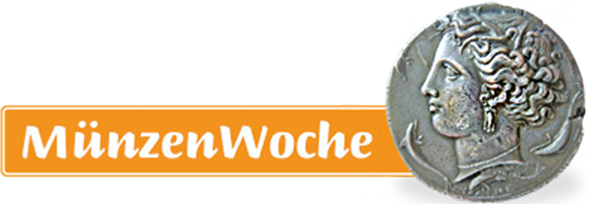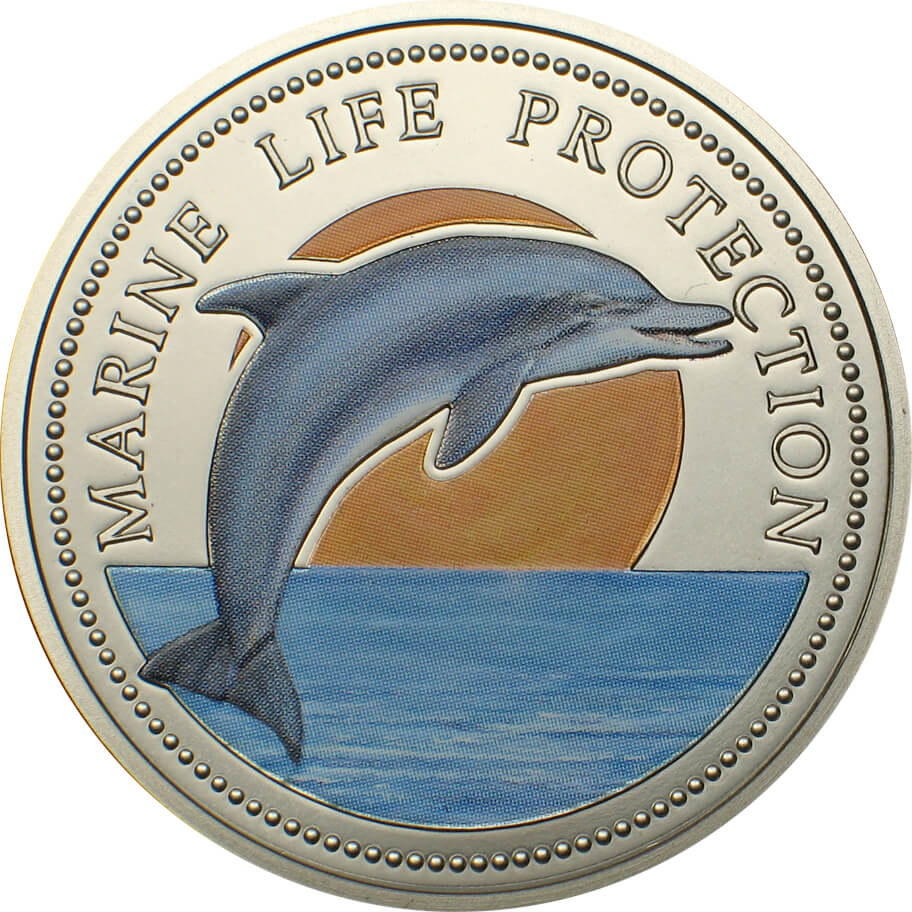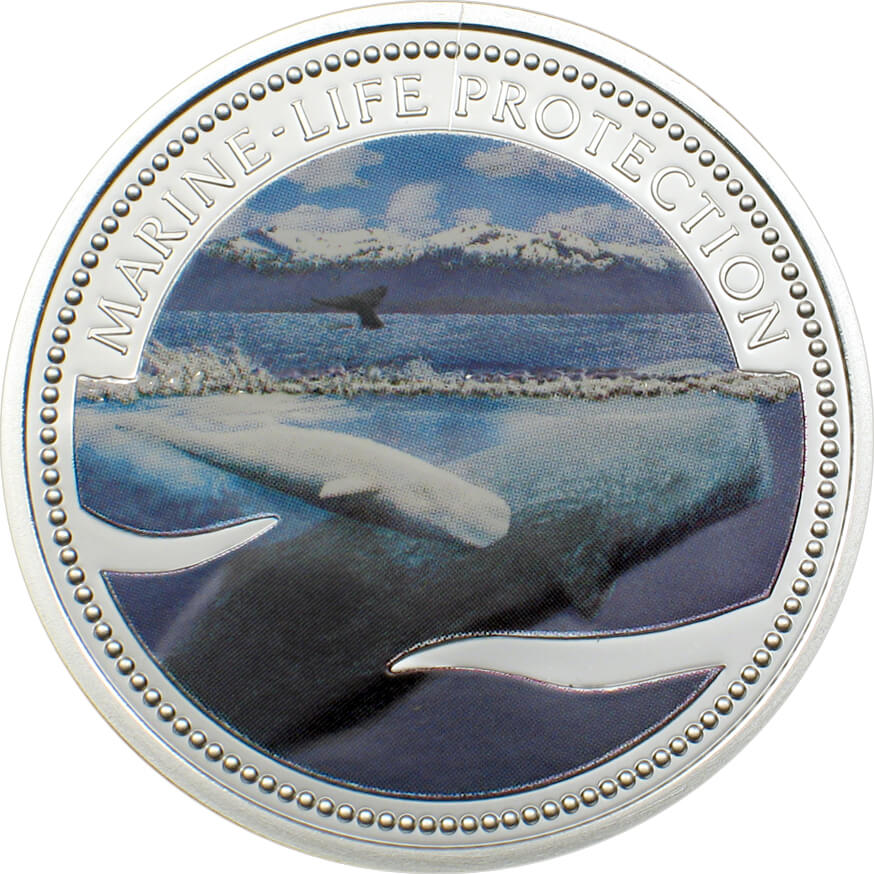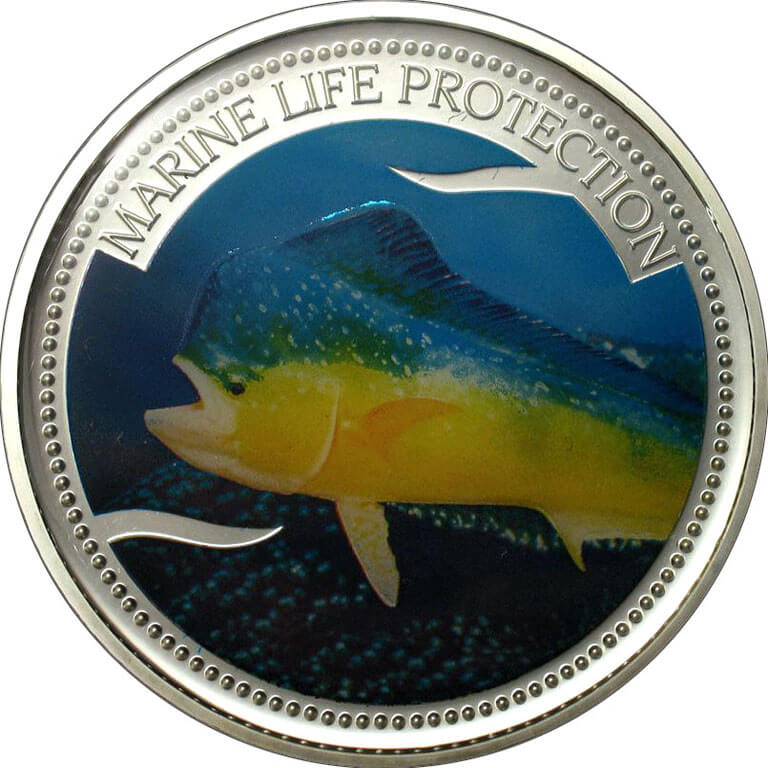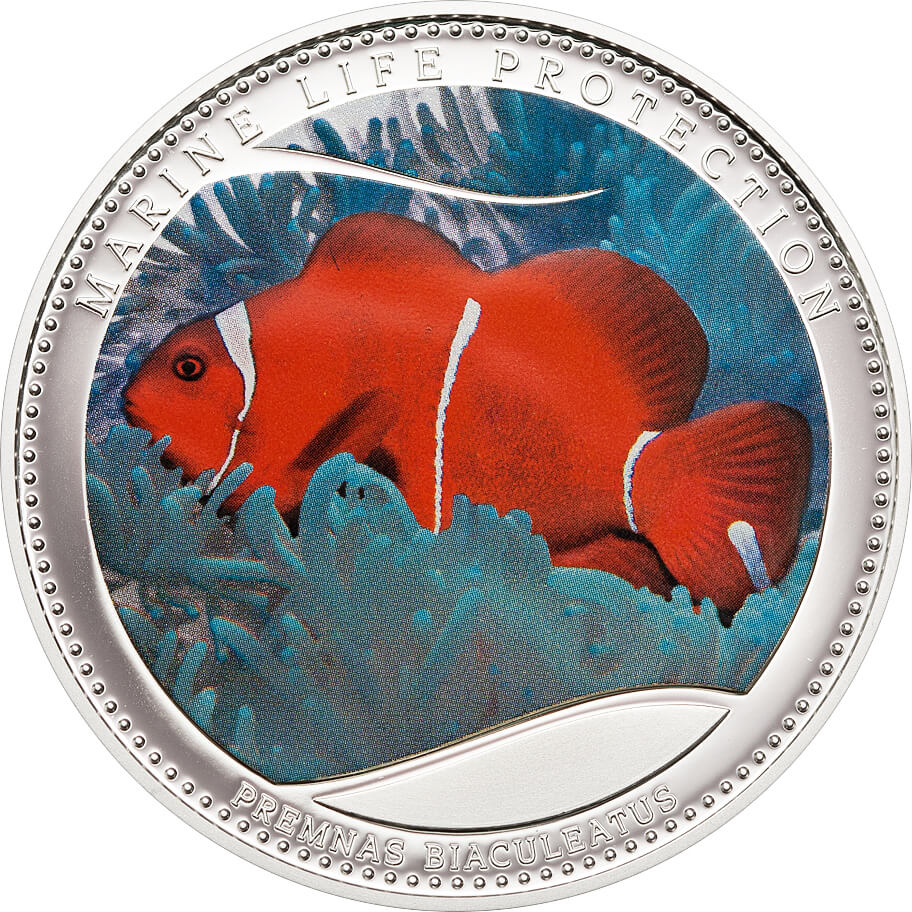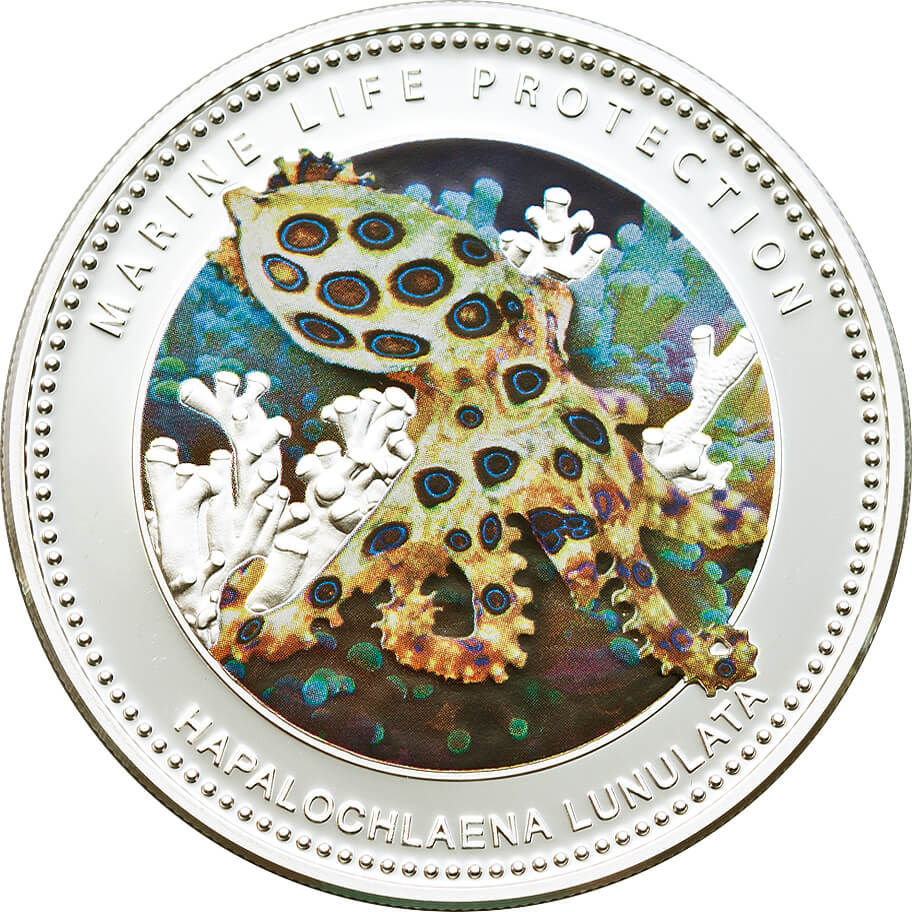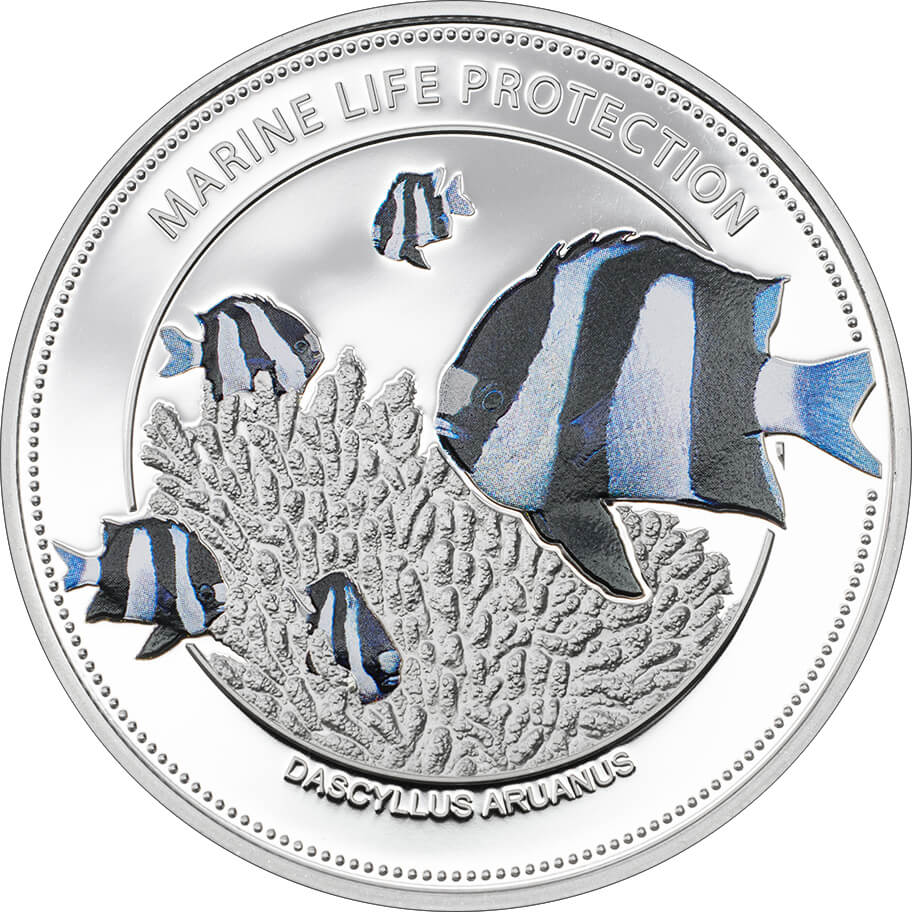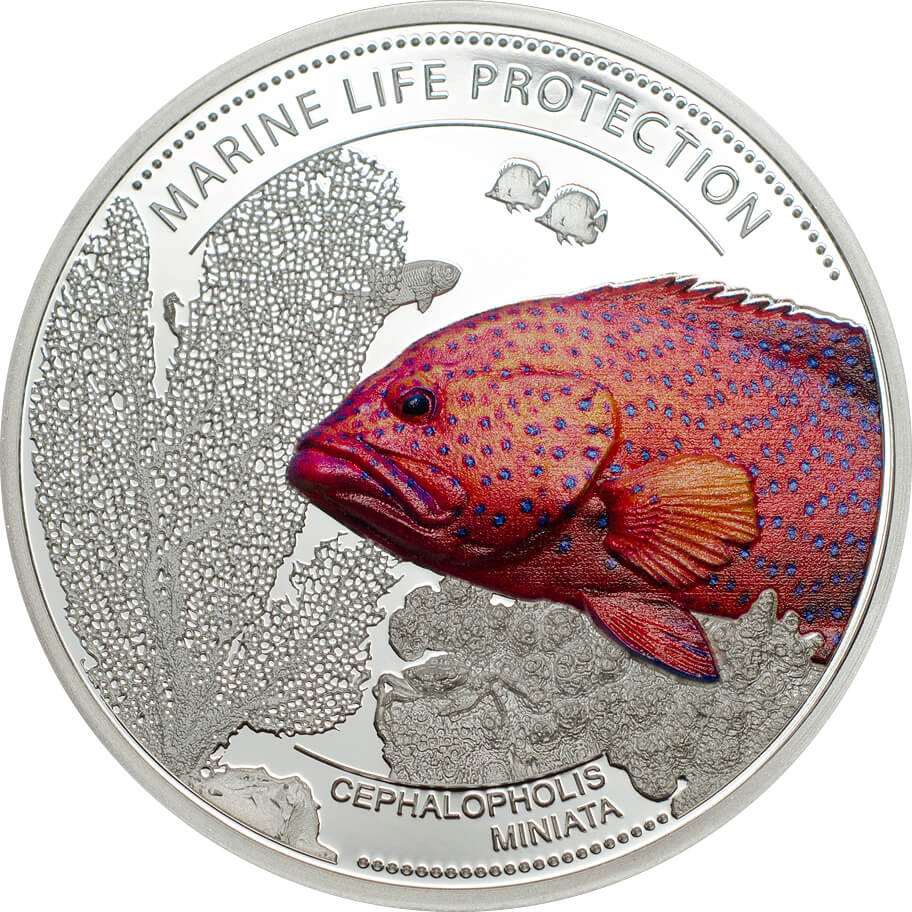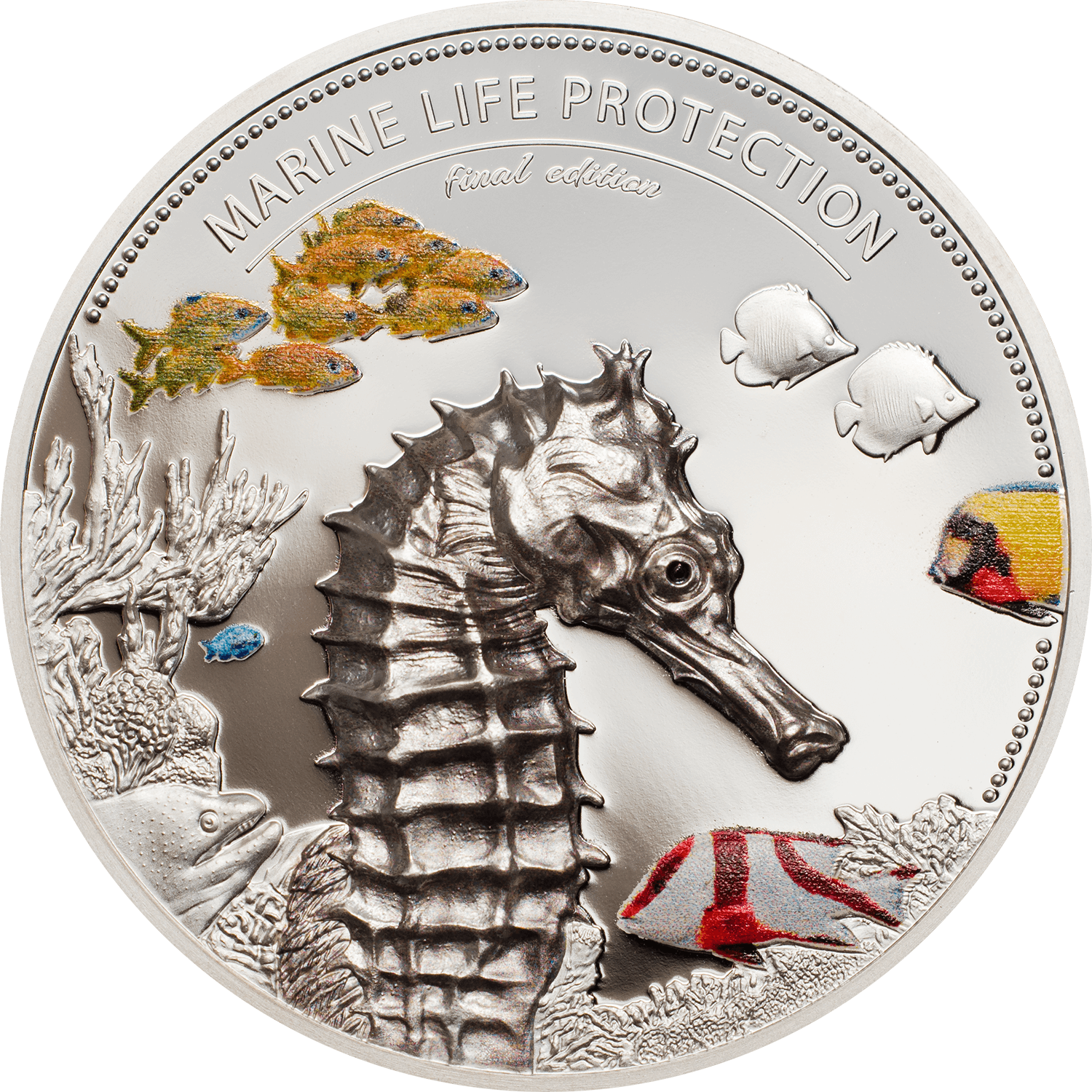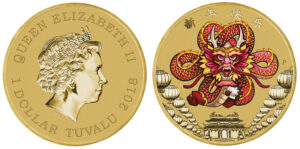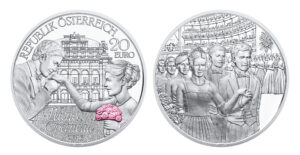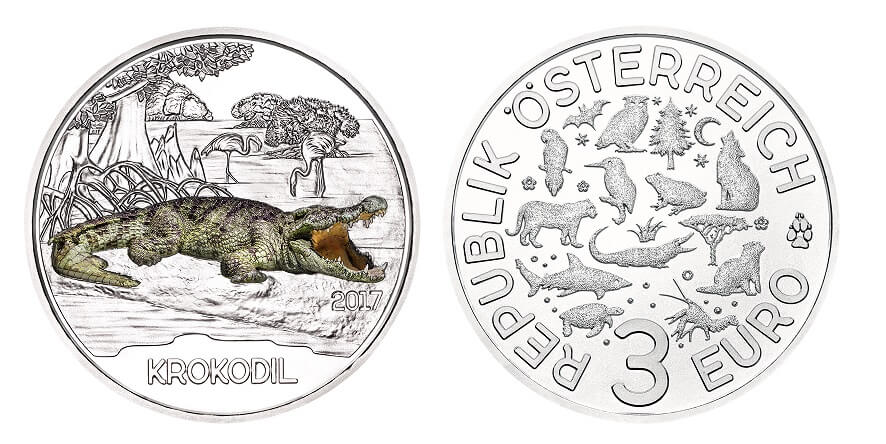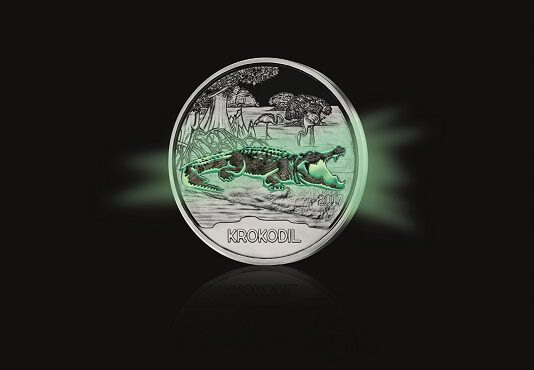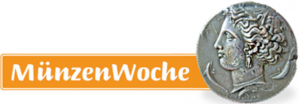How Colours Made Their Way Onto Coins
It was 28 years ago, and I still remember it as if it happened yesterday. For the first time, I visited the World Money Fair, which obviously wasn’t called World Money Fair in 1992 but Europa-Münzenmesse Basel and was held in the sports hall of St. Jakob. And my venerable boss walked through this very sports hall, dressed in suit and tie. He tore his hair, threw his hands in the air and yelled: “Now they went completely out of their minds! Mickey Mouse coins! They produce Mickey Mouse coins!”
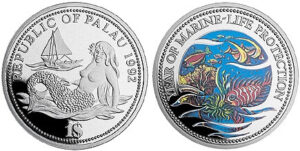
The world’s first colour coin: Palau. $1 in cupronickel 1992. The Liechtenstein forge of ideas Coin Invest Trust and the Swiss mint Huguenin, which celebrated its 150th anniversary in 2018, were responsible for this technological innovation. Photo: Coin Invest Trust.
The World’s First Colour Coin
The reason for his annoyance was a new product issued by Liechtenstein coin producer Coin Invest Trust in collaboration with the traditional mint Huguenin from Switzerland: the first two collector coins of the Marine Life Protection series issued on behalf of the small island country of Palau. They had printed a coloured motif on a $1 cupronickel piece (mintage: 50,000) and a $5 silver piece (mintage: 6,000) featuring several tropical fish and some marine plants on a blue surface. While the artistic value of this scenery might absolutely be questioned, Coin Invest Trust and Huguenin had definitely broken new numismatic ground with this coin. They had created the world’s first colour coin.
The Longest Running Series of Commemorative Coins
And just like that, the series that had started off so modestly became the longest running series of collector coins of the numismatic world. The Marine Life Protection series did not end until 2017(!), 25 years after it had started. And by looking at this commemorative coin series, you can perfectly observe how much the quality of colour application improved. While they first used a flat foil, which was applied to the coin, they soon switched to colour printing and a better resolution as well as more differentiated colours were achieved with every new issue. While colour application was initially only possible on flat surfaces, they started to play with the background in 2011/2. The struck relief was gradually incorporated into the depiction. At first, it could at most be described as ornamental, on the last issue of the Marine Life Protection series, though, relief and colour are treated completely equally. A high relief was combined with a small amount of colour applied to small low relief areas in the background.

The first colour coin that won a COTY as “Most historically significant”: Australia. $ 10, silver, “The Evolution of the Calendar”, issued by the Perth Mint.
A Delayed Success
It’s remarkable: the world’s first colour coin was despised by the professional world. It wasn’t awarded the COTY for the most innovative (and promising) coin of the year, which it would have deserved. This prize was won by a technique that didn’t have a bright future and was applied to an Albanian Olympic coin of 1991: the piece was composed of two masterfully minted parts, with the incuse depiction of one side matching the raised image of the other side perfectly.
The traditionally thinking jurors probably shared my boss’ opinion and didn’t want to have anything to do with “Mickey Mouse”. It took more than a decade until the first colour coin was awarded a Coty in 2003!
The market, however, was enthusiastic about the colour version. Especially Asian buyers, who re-discovered coin collecting at that time, bought huge quantities of colour coins. Business flourished for all those private coin producers and mints that had no reservations and included the new technology into their portfolio. The sales figures of these early colour coins were so high that even traditional mints started to think about producing them. Finally, in the mid-90s, it became increasingly harder to sell state commemorative coins on the collectors’ market. Therefore, mints that operated as profit centres and thus used to adapt their business strategies to the needs of the collectors’ market began to brood.
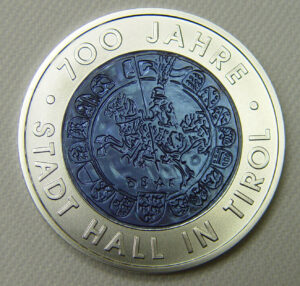
One of the biggest successes of Austrian Mint AG, the niobium coin, was initially intended to be an attractive alternative to colour coins. The first issue “700 Years of Hall in Tyrol” with a mintage of 50,000 specimens was sold out so quickly that the mintage of the following issues was increased to 65,000 pieces.
Why the Austrian Niobium Coin Was Created
The Austrian niobium coin became one of the most spectacular by-products in the process of searching for an alternative to numismatic colour printing. In their article on the Austrian niobium series in the Mint World Compendium 2012/2, Franz Artmüller and Alfred Gnadenberger explain that, back then, they thought about how to tag onto the success of colour coins without copying them. In other words: they wanted to create a colour coin without painting it.
The ideas of the technology department ranged from oxidation to questions of the refraction of light. They were not happy about the first results achieved with titanium, as the colour of titanium can only be changed into two different shades of grey by heating.
The success only came when the mint started to collaborate with Plansee, a high-tech company from Tyrol with a lot of expertise in dealing with very special metals: molybdenum, wolfram, tantalum – and niobium.
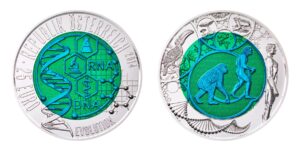
The first two-colour niobium coin issued by Austrian Mint in 2014 demonstrates how spectacular a coin can be whose colour was created by means of elaborate metal processing technologies. Mintage: 65,000 pieces.
After numerous tests, they decided to use niobium and combined a colour niobium centre and a silver ring. The first niobium coin “700 Years of Hall in Tyrol” of 2003 became a best-seller. The 50,000 pieces were sold out quickly and their prices increased enormously. The Catalog of World Coins of the Battenberg publishing house appraises the specimens issued at 37.90 euros to have a value of 450 euros today. By the way, the first niobium coin didn’t receive a COTY either. It wasn’t until the issue of 2008 that a COTY was awarded to this series – three later issues received one as well.

Schematic representation of pad printing: The desired image is transferred on a cliché. The more colours are to be applied, the more clichés are needed. Graphic: Harkonnen2 (2009) CC-BY 4.0
Pad Printing: How Colours Are Applied to Coins
Niobium coins are a special case and no collector would call them “colour coins”. Actual colour coins are coloured by means of a special printing technology, in most cases by pad printing. The advantage of this process is the soft pad made of silicone rubber that can also apply colour onto shaped surfaces, i.e. the coin’s relief. Of course, the relief must not be too high. By now, it is possible to print on reliefs of 0.3 mm without any problem, and that’s quite a lot!
However, the contours of the printed area aren’t quite as clear as they are when the image is printed on a flat sheet of paper.
Apart from that, the printing process works more or less as we’re used to. The printing colour is transferred to the cliché by means of a so-called squeegee. The parts that will later be coloured with this ink on the coin have previously been etched into the cliché. That’s why a bit of colour remains on the cliché after, in a second step, the excess ink is moved away from the cliché with a knife. The remaining ink is taken by the printing pad and transferred to the image. These steps have to be repeated for every printing colour. Today, it is possible to use up to eight different colours.
To ensure that the printed image is as perfect as hoped, the printing process is monitored by a camera system that immediately reports any deviation, even if it’s just a micrometre. The ink stations are immobile and the coin circulates from one station to the next.
The highly complex machines needed for such a task are often manufactured by Morlock Mechanik in Baiersbronn or Teca-Print in Thayngen, Switzerland. Also regarding the field of colour printing, it’s true that the machines used by mints all over the world for their production come from German-speaking countries. How such a machine looks like can be seen at the booth of the firm Morlock, who is a regular exhibitor at the World Money Fair.
The Limits of Colour Printing
However, it is quite unlikely that large proportions of our circulation coins will ever be coloured. The reason for this is that this technology has a clear limitation: pad printing requires time. Commercially available machines can produce a maximum of 350 coins per hour, or 250 coins regarding the case of four-colour printing. Considering that modern minting presses spit out 750 coins per minute(!), you understand why applying colour to circulation coins is rather out of question.
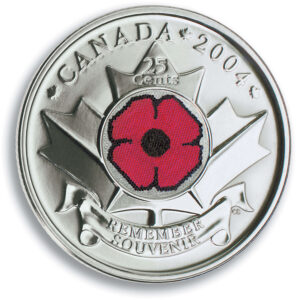
Canada. 25 cents 2004. The first colour circulation coin whose colour wasn’t applied through time-consuming pad printing but by means of quick screen printing.
The First Colour Circulation Coin
All this doesn’t mean that colour circulation coins don’t exist at all. The Royal Canadian Mint is proud of having produced the world’s first colour coin intended for circulation. On 21 October 2004, 25 cent pieces commemorating the 60th anniversary of the landing of the allies in Normandie were released. A total of 28,972,000 specimens was produced. To apply colour to such a large number of coins in a reasonable time, black and red ink were applied by screen printing onto a specially prepared surface. However, some users complained that the colour wasn’t scratch resistant and came off in circulation.
Colour circulation coins were so popular in Canada, that the issue was released again. In 2006, 25 cent pieces with a mintage of 29,798,000 were issued featuring the pink ribbon as commemorative coins celebrating 20 years of the Canadian Breast Cancer Foundation. By the way, this coin was awarded the COTY, the earlier piece from 2004 was not. And the coin didn’t win as most innovative but as most inspiration coin.

Canada 25 cents 2012. Prehistoric Creatures. Pachyrhinosaurus lakustai. The phosphorescent ink used for printing the image glows in the dark.
Playing With Colour
Ever since, Canada has been considered a role model regarding the production of colour coins. The country developed many new technologies and carried out extensive research in the field of special properties of colours.
You must have seen the simple circulation coins of 2004 to appreciate the effects achieved by the Royal Canadian Mint with colour by now. A wonderful example for this are the highly popular Canadian dinosaur coins. The series’ first issue of 2014 won the COTY as most innovative coin. The colour layer of the delicately coloured Pachyrhinosaurus lakustai contains a phosphorescent ink, which makes the animal’s skeleton glow in the dark.
By now, the Royal Canadian Mint applies several colours with different phosphorescent properties to their coins and carries out research in the field of nano pigments in order to obtain colours that are more durable than anything we know and which can be produced much faster than by means of traditional pad printing.
Colour Coins as Products for Special Target Groups?
Colour coins have become a matter of course produced by numerous mints. However, the target groups they hope to attract still seem to be rather precisely defined. They mainly think about the Asian market, where coin collectors have no reservations about colours on coins. Additionally, the marketing divisions of mints have their sight set mainly on non-collectors, whom they want to convince to become buyers by depicting popular motifs. In general, it is believed that it is easier to seduce a young public to collect coins with colour than it is without.
To illustrate this, let’s take a look at some of the Perth Mint’s colour coins for 2018. For instance, they produce – just like many other mints – commemorative coins for the Chinese New Year, and these products are highly popular in the Asian world. 2018 was the year of the dog, which is not depicted on the $ 1 coin shown here. Instead, the coin features a dragon in splendid colours. A dragon’s shape made of cloth and inflated by the wind plays a decisive role during New Year’s celebrations. In the Asian world, the New Year is a reason for exchanging gifts. And because people like to buy these coins as gifts, they are available in many attractive forms of packaging. Here you can see a magnificent first day cover with stamps and coin.
And, of course, colour versions of coins designed for huge fan communities of movies and television are produced, too. Whether it be Spider-Man, Star Wars, Star Trek or Ghostbusters, heroes of movies have already found their way onto coins a long time ago. And yet, even if a few state mints occasionally dare to depict an actor on a commemorative coin, such depictions have remained a rather exclusive feature of private mints – and they tend to use colour quite often for such coins.

The Perth Mint’s commemorative issue intended to be given to freshly graduated sons and daughters by their relatives was obviously produced in a colour version to attract a young audience.
The reason is that the target group of such coin issues does not consist of traditional coin collectors but is a young audience (in terms of collecting, a buyer under the age of 50 can be considered “young”). Mints believe that colour coins are more in line with the aesthetics young people are used to.
Colours Have Arrived at the Centre of the Collecting Community
In 2015, Austrian Mint decided to produce colour coins, too. As a subsidiary of the central bank of Austria, Austrian Mint is committed to an issuing policy that doesn’t scare off Austrian citizens too much. Therefore, only a little bit of colour was applied to Austria’s first colour coin. A touch of pink is used to highlight the bouquet of a Debutant, who decorates the obverse of this coin minted at the beginning of 2016 as a symbol for the Vienna Opera Ball. 50,000 pieces of this coin were issued. The coin’s sales figures weren’t bad, however, even two years after it was issued for the first time it could still be purchased at the website of Austrian Mint.
Things are completely different regarding the animal talers, which have been issued since October 2016 every three month with a mintage of 50,000 pieces. Austrian Mint had initially created this product to offer a coin in the lower price segment for young collectors. Thus, the issue price was set at 9.90 euros and an attractive collector’s album was designed in a language suitable for children. One may wonder how many of these coins, which are much sought-after among collectors, actually made it into children’s hands. After all, by now these pieces achieve prices of more than ten times their issue price. By the way, this was quite a surprise for those responsible.
And that tells us that by now most European coin collectors no longer consider colour coins a stupid craze but believe that colour is an enriching element of commemorative coinage.
Oh yes, and colour coins featuring Mickey Mouse are now available from more than one mint. I’m sure my former boss is thrilled about that.
You can find many coloured coins in the Cosmos of Collectibles database.
Falls Sie den Artikel auf Deutsch lesen möchten, finden Sie ihn im Münzenmarkt 22. Hier können Sie das PDF gratis herunterladen.





